Welcome to our free classical music site

Do you write about classical music? Are you a blogger? Want to team up with Classical Connect? Send us a message, let's talk!

Do you write about classical music? Are you a blogger? Want to team up with Classical Connect? Send us a message, let's talk!
May 9, 2016. Monteverdi. Claudio Monteverdi, one of the most important composers in the history of European music, who bridged the Renaissance with the nascent Baroque and almost singlehandedly created a new musical form, the opera, was born on this day in 1567 in Cremona, Italy. We’ve written about Monteverdi in the past (here and here), so we’ll focus on just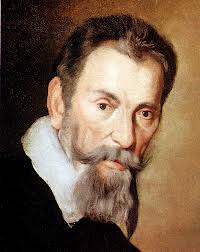 one, but critical, period in his life – his almost 20 year stay in Mantua at the court of Gonzagas. The Gonzagas, who ruled Mantua from the early 14th century till the beginning of the 18th, were one of the most illustrious and old houses of Italy. They lived in the famous Palazzo Ducale, which, with its 500 rooms, was one of the largest palaces in the country. The rule of Duke Vincenzo, from 1587 to 1612, was a high point. Duke Vincenzo Gonzaga was an extravagant patron of the arts and his court was brilliant. The Duke surrounded himself with poets (including Torquato Tasso), painters (Peter Paul Rubens was one of his favorites) and musicians – the court orchestra was one of the best, and led by the famous composer Giaches De Wert. The Duke spent so lavishly that by the end of his rule the Gonzagas ran out of money; historians believe that Vincenzo’s profligacy led to the decline of the Duchy. Monteverdi moved to Mantua around 1590 when he was 23. Though he had already established himself as a composer in his native Cremona, at the court he started at the bottom, as one of the court musicians. The influence of De Vert on his compositions of the period is unmistakable. Monteverdi’s talents didn’t go unnoticed for long as the Duke drew him into his inner circle. Monteverdi was one of the few musicians to accompany the Duke on his frequent trips. On one of such trip in 1600, they went to Florence to join the celebration of the wedding of Maria de’ Medici, daughter of the Grand Duke of Tuscany, to the French King Henri IV. Monteverdi, with the rest of Vincenzo’s retinue, attended the performance of Euridice, an opera by Jacopo Peri, one of the first operas ever written.
one, but critical, period in his life – his almost 20 year stay in Mantua at the court of Gonzagas. The Gonzagas, who ruled Mantua from the early 14th century till the beginning of the 18th, were one of the most illustrious and old houses of Italy. They lived in the famous Palazzo Ducale, which, with its 500 rooms, was one of the largest palaces in the country. The rule of Duke Vincenzo, from 1587 to 1612, was a high point. Duke Vincenzo Gonzaga was an extravagant patron of the arts and his court was brilliant. The Duke surrounded himself with poets (including Torquato Tasso), painters (Peter Paul Rubens was one of his favorites) and musicians – the court orchestra was one of the best, and led by the famous composer Giaches De Wert. The Duke spent so lavishly that by the end of his rule the Gonzagas ran out of money; historians believe that Vincenzo’s profligacy led to the decline of the Duchy. Monteverdi moved to Mantua around 1590 when he was 23. Though he had already established himself as a composer in his native Cremona, at the court he started at the bottom, as one of the court musicians. The influence of De Vert on his compositions of the period is unmistakable. Monteverdi’s talents didn’t go unnoticed for long as the Duke drew him into his inner circle. Monteverdi was one of the few musicians to accompany the Duke on his frequent trips. On one of such trip in 1600, they went to Florence to join the celebration of the wedding of Maria de’ Medici, daughter of the Grand Duke of Tuscany, to the French King Henri IV. Monteverdi, with the rest of Vincenzo’s retinue, attended the performance of Euridice, an opera by Jacopo Peri, one of the first operas ever written.
The Gonzagas were very close to the house of Este of the nearby Ferrara (the third wife of Alfonso II d’Este, the Duke of Ferrara at the time, was a Gonzaga). Alfonso shared Vincenzo’s love of arts and music; his court orchestra was led by Luzzasco Luzzaschi, a noted composer; he also maintained Concerto delle donne, a female vocal ensemble famous for their virtuosity. Monteverdi’s music was performed in Ferrara almost as often as in Mantua; in 1597 he was about to dedicate a book of madrigals to Duke Alfonso when the Duke died, childless, thus ending the Este’s dynasty in Ferrara.
While in Modena, Monteverdi wrote several books of madrigals (books Three through Five, the first two books were composed while Monteverdi lived in Cremona). Book Five is considered very significant, as it marks the shift from the polyphonic Renaissance style to a more monodic Baroque. In 1607 he composed his first opera, Orfeo, which firmly established opera as new art form; it’s also the earliest opera that is still being regularly performed. We’ll hear two madrigals from Book V: T'amo mia vita, performed by the ensemble Artek, under the direction of Gwendolyn Toth (here), and Che dar più vi poss'io, with Il Nuove Musiche conducted by Krijn Koetsveld (here).
PermalinkMay 2, 2016. Scarlatti, Brahms, Tchaikovsky. Three famous composers were born this week. May 2nd is the birthday of Alessandro Scarlatti, a very important early opera composer and the father of Domenico. Scarlatti was born in 1660. Then, on May 7th comes the unfortunate coupling of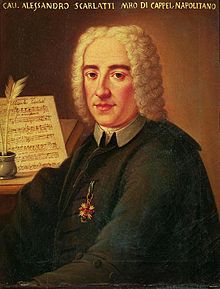 Johannes Brahms, born in 1833, and Pyotr Ilyich Tchaikovsky, born in 1840, so very different but both representing the best in their national schools. Over the years we’ve written extensively about all three of them: here and here about Scarlatti, and of course numerous times about both Brahms and Tchaikovsky. So on this occasion we’ll celebrate their anniversaries with performances of just one piece each. We have to admit that we’re absolutely in love with the aria Mentre io godo in dolce oblio (here) from Oratorio La Santissima Vergine del Rosario and consider it on par with the best by Handel. It helps, of course, that it’s performed by the phenomenal Cecilia Bartoli (with Les Musiciens du Louvre conducted by Marc Minkowski). To carry the comparison between Scarlatti and Handel a bit further (hopefully not too far!), here’s a historical tidbit. Scarlatti’s La Santissima Vergine del Rosario was premiered in Rome in 1707. One of Scarlatti’s patrons during that time was Prince Francesco Maria Ruspoli, and Santissima was premiered on Easter Sunday at the Ruspoli palazzo. Around that time, the 22-year-old Handel arrived in Rome and almost immediately was hired by Prince Ruspoli as his Kapellmeister. One year later Handel composed his own oratorio, La Resurrezione. This one too was staged, lavishly, in the main hall on the ground floor of Ruspoli’s palazzo, and also on Easter Sunday. It’s safe to assume that Handel was familiar with Scarlatti’s work, although there are no discernable borrowings, except for the general format of the work.
Johannes Brahms, born in 1833, and Pyotr Ilyich Tchaikovsky, born in 1840, so very different but both representing the best in their national schools. Over the years we’ve written extensively about all three of them: here and here about Scarlatti, and of course numerous times about both Brahms and Tchaikovsky. So on this occasion we’ll celebrate their anniversaries with performances of just one piece each. We have to admit that we’re absolutely in love with the aria Mentre io godo in dolce oblio (here) from Oratorio La Santissima Vergine del Rosario and consider it on par with the best by Handel. It helps, of course, that it’s performed by the phenomenal Cecilia Bartoli (with Les Musiciens du Louvre conducted by Marc Minkowski). To carry the comparison between Scarlatti and Handel a bit further (hopefully not too far!), here’s a historical tidbit. Scarlatti’s La Santissima Vergine del Rosario was premiered in Rome in 1707. One of Scarlatti’s patrons during that time was Prince Francesco Maria Ruspoli, and Santissima was premiered on Easter Sunday at the Ruspoli palazzo. Around that time, the 22-year-old Handel arrived in Rome and almost immediately was hired by Prince Ruspoli as his Kapellmeister. One year later Handel composed his own oratorio, La Resurrezione. This one too was staged, lavishly, in the main hall on the ground floor of Ruspoli’s palazzo, and also on Easter Sunday. It’s safe to assume that Handel was familiar with Scarlatti’s work, although there are no discernable borrowings, except for the general format of the work.
It is impossible to pick one representative piece by either Brahms or Tchaikovsky, so, with guided randomness, here are two compositions. A 1886 piano piece Dumka by Tchaikovsky, not to be confused with several “Dumka” compositions by Antonin Dvořák, isn’t played often on the concert scene, but it is very familiar to the Moscow audience: over the years, it has been performed repeatedly in the second round of the Tchaikovsky piano competitions. Here it is performed by a young Ukrainian pianist Stanislav Khristenko. The Piano sonata no. 3 written by the 20-year-old Brahms in 1853 isn’t too popular either: it’s long (35 minutes), in unusual five movements, and in parts uneven. The third piano sonata is also the last one for Brahms, who wrote all three in a span of less than two years. For all the problems, it’s very much worth listening to, especially when performed well, as it is here, by the young Japanese pianist Misato Yokoyama.Permalink
 Ms. Thomas and Stephen Burns, a Chicago-based conductor, trumpeter, composer, and the Artistic Director of the Fulcrum Point New Music Project, are organizing a unique event, the Ear Taxi Festival 2016, a celebration of contemporary music in Chicago. The festival will feature 300 musicians, 53 world premieres and 4 installations in its six days of concerts, lectures, webcasts and artist receptions. Explaining the name of the festival, Ms. Thomas says: “We want to take your ears on a wide variety of ‘taxi rides’ through the world of contemporary music. At
Ms. Thomas and Stephen Burns, a Chicago-based conductor, trumpeter, composer, and the Artistic Director of the Fulcrum Point New Music Project, are organizing a unique event, the Ear Taxi Festival 2016, a celebration of contemporary music in Chicago. The festival will feature 300 musicians, 53 world premieres and 4 installations in its six days of concerts, lectures, webcasts and artist receptions. Explaining the name of the festival, Ms. Thomas says: “We want to take your ears on a wide variety of ‘taxi rides’ through the world of contemporary music. At 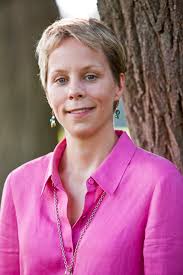 every concert, you’ll hear a mix of ensembles and musical styles that reflects the incredible depth and breadth of new music both here in Chicago and beyond.” The Festival will feature the music of more than 70 composers, from well-established, like Shulamit Ran, Ms. Thomas, Bernard Rands and George Flynn, to young but very promising. Here’s the list of all composers (with biographies). The performers are among the best in Chicago: ensembles, like the Avalon Quartet, the Chicago Composers Orchestra, Ensemble Dal Niente, the Fifth House ensemble and many more, as well as a number of individual performers. The Festival will start on October 5th and will run till October 10th of 2016. The concerts will take place at several venues: the Harris Theater, the Chicago Cultural Center, the Pritzker Pavilion of the Millennium Park, the University of Chicago and several other smaller ones. Here’s how you can buy tickets to the Festival events.
every concert, you’ll hear a mix of ensembles and musical styles that reflects the incredible depth and breadth of new music both here in Chicago and beyond.” The Festival will feature the music of more than 70 composers, from well-established, like Shulamit Ran, Ms. Thomas, Bernard Rands and George Flynn, to young but very promising. Here’s the list of all composers (with biographies). The performers are among the best in Chicago: ensembles, like the Avalon Quartet, the Chicago Composers Orchestra, Ensemble Dal Niente, the Fifth House ensemble and many more, as well as a number of individual performers. The Festival will start on October 5th and will run till October 10th of 2016. The concerts will take place at several venues: the Harris Theater, the Chicago Cultural Center, the Pritzker Pavilion of the Millennium Park, the University of Chicago and several other smaller ones. Here’s how you can buy tickets to the Festival events.
April 25, 2016. Augusta Read Thomas and Ear Taxi Festival. Augusta Read Thomas is one of the most interesting contemporary American composers. Prolific and active, she’s currently serving as the University Professor of Composition at the University of Chicago. To quote the music critic Edward Reichel, "Augusta Read Thomas has secured for herself a permanent place in the pantheon of American composers of the 20th and 21st centuries. She is without question one of the best and most important composers that this country has today. Her music has substance and depth and a sense of purpose. She has a lot to say and she knows how to say it — and say it in a way that is intelligent yet appealing and sophisticated.” Here are her Angel Musings, performed by the Orion Ensemble.
Please go to the Festival’s web page for more information. The Festival promises to be a wonderful affair and we hope that you’ll will have a chance to enjoy it.Permalink
Aril 18, 2016. Prokofiev. Sergei Prokofiev’s 125th anniversary is on April 23rd. One of the greatest composers of the first half of the 20th century, his life was as tempestuous as the century itself. He was born in what is now Ukraine, spent his youth in Moscow and St.Petersburg and by.jpg) the age of 25 was famous as a composer and pianist. By that time he had already written a ballet for Sergei Diaghilev which made him a name in Paris. Following the First World War and the October Revolution, he left Russia for the United States but two years later moved to France. By then he was the composer of several operas, a symphony, two ballets, concertos for piano and the violin, and four piano sonatas. In the late 1920s he returned to Russia for a series of concerts and after that, while still living in France, became more involved with the Soviet musical establishment. Then, in 1936, he returned to the Soviet Union – permanently. He wrote Peter and the Wolf for Natalia Sats’s Children’s theater and collaborated with Sergei Eisenstein on the film Alexander Nevsky, but also was compelled to write “Soviet” music, like the infamous Zdravitsa, written for Stalin’s 60th birthday and Cantata for the 20th Anniversary of the October Revolution (even though written on texts by Marx and Lenin, it sounded too unconventional for the Soviet musical apparatchiks and wasn’t performed during Prokofiev lifetime).
the age of 25 was famous as a composer and pianist. By that time he had already written a ballet for Sergei Diaghilev which made him a name in Paris. Following the First World War and the October Revolution, he left Russia for the United States but two years later moved to France. By then he was the composer of several operas, a symphony, two ballets, concertos for piano and the violin, and four piano sonatas. In the late 1920s he returned to Russia for a series of concerts and after that, while still living in France, became more involved with the Soviet musical establishment. Then, in 1936, he returned to the Soviet Union – permanently. He wrote Peter and the Wolf for Natalia Sats’s Children’s theater and collaborated with Sergei Eisenstein on the film Alexander Nevsky, but also was compelled to write “Soviet” music, like the infamous Zdravitsa, written for Stalin’s 60th birthday and Cantata for the 20th Anniversary of the October Revolution (even though written on texts by Marx and Lenin, it sounded too unconventional for the Soviet musical apparatchiks and wasn’t performed during Prokofiev lifetime).
He continued composing during the great Patriotic War, as WWII was called in the Soviet Union, part of which he spent in Almaty, Kazakhstan. Estranged from his first wife, Lina, since 1941, he married Mira Mendelssohn, 24 years his junior, after the Soviet government officially “annulled” his marriage to Lina. Lina in the meantime was arrested and sent to the Gulag. In 1948 Prokofiev himself almost ended up there: he was severely criticized for the 6th Symphony and the opera The Story of a Real Man, which was staged at the Kirov Theater but then immediately cancelled. Prokofiev’s health was failing and he moved to his dacha outside of Moscow. His doctors prohibited any exertion and allowed him to compose for just one hour a day. He died on March 5th of 1953, the same day as Stalin. The Soviet Union descended into an official, utterly hysterical mourning. Hundreds of people were trampled to death during Stalin’s funeral procession. Prokofiev’s death wasn’t reported for days, as all periodicals were filled with articles eulogizing Stalin.
We’ll hear his Piano sonata no. 6, op. 82. Prokofiev stated working on it in 1939 (that year he also started piano sonata nos. 7 and 8 – together they’re known, somewhat inappropriately, as “War Sonatas”). No. 6 was completed in 1940 and premiered by Prokofiev himself in April of that year Prokofiev met the pianist Sviatoslav Richter during that time and Richter became a great champion of this works. Richter and Emil Gilels, who premiered Sonata no. 8, created a number of classic recording of the “War Sonatas,” and to this day they count among the very best. Still, there are some very interesting performances made by younger musicians. Listen to this live recording made by Yuja Wang – the verve and the energy are quite extraordinary, as is the technique. The portrait of Prokofiev, above, was made by the Russian artist Pyotr Konchalovsky in 1934.Permalink
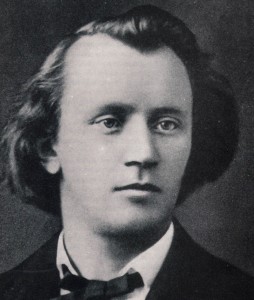 The four Ballades of Brahms’s opus 10 were the first foreshadowing of the eventual direction his output for piano would take. Composed in 1854, they followed the completion of his third and last piano sonata by roughly a year, and were his first foray into the newfound realm of miniatures. Perhaps it was mere curiosity that led the young composer—Brahms was only in his early twenties at the time—from his Classically inspired sonatas to the miniatures born of the Romantic period, yet it would be the latter pieces that would largely come to define his output as composer for the piano. Although nearly a quarter of a century would pass, in which time Brahms championed the large-scale variation form with such works as the Paganini and Haydn Variations, and the Variations and Fugue on a Theme of G.F. Handel, he returned to the miniature in his 8 Klavierstücke, op. 76. This work would, in turn, prove to be only the foundation for the ethereal and introspective pieces to come during the 1890s.
The four Ballades of Brahms’s opus 10 were the first foreshadowing of the eventual direction his output for piano would take. Composed in 1854, they followed the completion of his third and last piano sonata by roughly a year, and were his first foray into the newfound realm of miniatures. Perhaps it was mere curiosity that led the young composer—Brahms was only in his early twenties at the time—from his Classically inspired sonatas to the miniatures born of the Romantic period, yet it would be the latter pieces that would largely come to define his output as composer for the piano. Although nearly a quarter of a century would pass, in which time Brahms championed the large-scale variation form with such works as the Paganini and Haydn Variations, and the Variations and Fugue on a Theme of G.F. Handel, he returned to the miniature in his 8 Klavierstücke, op. 76. This work would, in turn, prove to be only the foundation for the ethereal and introspective pieces to come during the 1890s.
April 11, 2016. Four Ballades op. 10 by Brahms. Today we’re publishing Joseph DuBose’s article on one of Johannes Brahms’s youthful compositions, Four Ballades op. 10. We’ll illustrate them with performances by Sevgi Giles. ♫
As a musical form, the ballade takes its name from the literary tradition of ballad poetry, which often employed grand themes of heroism or mythology. The ballade became established primarily at the hands of Chopin, who composed four examples between 1831 and 1842. Though it is suggested Chopin’s compositions were inspired by the poetry of Adam Mickiewicz, there is no direct evidence of this from the composer himself. Instead, the term ballade for Chopin seemed to have a similar connotation as the fantasia, a rather free development of ideas with little or no expectation as to formal arrangement, yet also unified with a greater sense of coherence—the development of a musical “narrative,” so to speak. It is natural, then, that Chopin’s ballades borrowed from the established conventions of sonata form, and thereby furthered the weighty discourses found within them.
Perhaps the most significant set of the ballades to follow Chopin’s was that of Brahms, though other notable composers, such as Franz Liszt, would compose their own ballades. Brahms approached the ballade in the same manner as he would many of the piano pieces of his last years—i.e., the three-fold division of the ternary form. Brahms’s ballades in this regard are less expansive as Chopin’s. All four embody some variation of a tripartite form. The first, perhaps, has the closest connection to Chopin. While in ternary form, its middle section, instead of presenting new material, develops upon that of the principal theme. Yet, its monothematicism and abbreviated reprise hardly qualify it as a bona-fide sonata form. The second employs a modified ternary, or, perhaps more appropriately, arch form, while the fourth nearly presents a complete rondo. Only the third is composed in a blatant ternary design. (Continue reading here).Permalink
April 4, 2016. Johann Kuhnau. We’ve recently mentioned Kuhnau’s name several times, in connection with Georg Philipp Telemann and Johann Sebastian Bach. Kuhnau’s music is not very popular these days, but in his time, as the Leipzig Thomaskantor,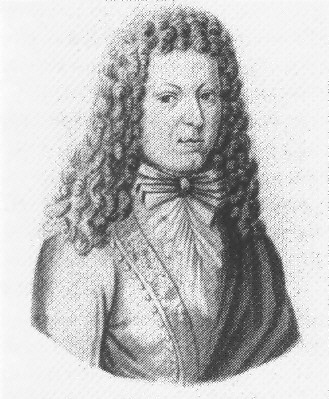 he was one of the most famous musician in the German-speaking lands. Kuhnau was not just a composer: he was also a lawyer, write, philosopher, linguist, theologian and mathematician. No wonder the Leipzig city fathers were dissatisfied with Johann Sebastian Bach, who succeeded Kuhnau as Thomaskantor: upon Bach’s death, while looking for a replacement, they said that they need a real Kantor, not just a Kapellmeister, meaning a person who would be a teacher (as Kuhnau was), not just a musician.
he was one of the most famous musician in the German-speaking lands. Kuhnau was not just a composer: he was also a lawyer, write, philosopher, linguist, theologian and mathematician. No wonder the Leipzig city fathers were dissatisfied with Johann Sebastian Bach, who succeeded Kuhnau as Thomaskantor: upon Bach’s death, while looking for a replacement, they said that they need a real Kantor, not just a Kapellmeister, meaning a person who would be a teacher (as Kuhnau was), not just a musician.
Kuhnau was born Johann Kuhn on April 6th of 1660 in Geising, Saxony, a small town on the border with Bohemia, where the family came from. From an early age Johann showed great scholastic aptitude; he also had a fine voice. At the age of ten he was sent to Dresden. There he studied the organ playing with the court musicians and for a while sung at Kreuzkhirche, famous to this day for its boys choir. He also found time to learn two languages, French and Italian. The plague epidemic forced him to return to Geising, but soon after he went to Zittau, famous for its Gimnasium, to further his education. In addition to his studies, he played the organ at Johanniskirche and even served as an acting Kantor. In 1682, upon graduating from the Gimnasium, he moved to Leipzig to study law at the university. He applied for the position of the organist at Thomaskirche, which he didn’t get at first; two years later, in 1684, he received the appointment. In 1688 Kuhnau published his dissertation and started practicing law (all the while continuing as the organist at Thomaskirche). Around that time, he also published several collections of his keyboard compositions. Even that was not all: he somehow found time to study mathematics and two more languages, Greek and Hebrew. He wrote a satirical novel and also translated several French and Italian books into German. In 1701 the previous Kantor of Thomaskirche, Johann Schelle, died and Kuhnau was appointed the new Kantor. At Thomasschule Kuhnau taught several classes (including Latin – something neither Bach nor Telemann, whom the city council wanted to hire as the Kantor instead of Bach, were ready to do). As the Kantor he directed music at several major Leipzig churches and the University.
Telemann, who arrived in Leipzig at the time when Kuhnau became the Kantor, was young and ambitious. He established a rival musical organization, Collegium Musicum, and revived the opera, attracting many good singers from the Thomaschor. He even acquired permission to write music for Thomaskirche, thus encroaching on Kuhnau authority. Kuhnau by that time was in ill health and his protestations were often ignored. Nonetheless, Kuhnau continued to serve as the Kantor for the rest of his life. He died in Leipzig on June 5th 1722.
Much of Kuhnau’s music output consists of keyboard compositions and sacred works, most of which were lost. Among his keyboard pieces, the set of six sonatas, the so-called “Biblical Sonatas,” is the most important. Kuhnau gave each sonata an elaborate title and separately described each movement. We’ll hear the first of these sonatas, which is called “The Combat Between David and Goliath." It consists of eight movements, their wonderfully poetic (and learned) subtitles are: The Boasting of Goliath; The Trembling of the Israelites at the Appearance of the Giant, and Their Prayer to God; The Courage of David, and His Keen Desire to Repel the Pride of His Terrifying Enemy, With the Confidence That He Puts in the Help of God; The Combat Between the Two and Their Struggle; The Stone Is Thrown From the Slingshot Into the Brow of the Giant; Goliath Falls; The Flight of the Philistines, Who Are Pursued and Slain by the Israelites; The Joy of the Israelites Over Their Victory; Musical Concert of the Women in Honor of David and The General Rejoicing, and the Dances of Joy of the People. The organist is John Butt.Permalink